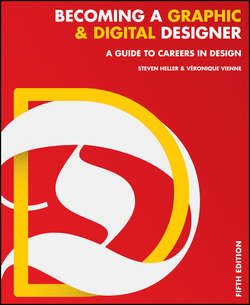Читать книгу Becoming a Graphic and Digital Designer - Heller Steven - Страница 3
На сайте Литреса книга снята с продажи.
Foreword
ОглавлениеThis is not your grandmother's graphic design. Nor is it your older brother's or sister's. The rate of speed at which the practice moves is cyclonic. All you have to do is look around to see that the world of design involves media that were inconceivable when grandmas were starting their careers.
– From the Preface of 4th Edition
This brand new edition represents a brand new era of graphic design, which is part graphic, almost entirely digital, and decidedly transitional. One of the proposed titles for this book was Becoming an Integrated Designer because traditional graphic and relatively new digital design are indeed merging into one practice. Likewise, it could have been called Becoming an INTEGRAL Designer because it is integral for practioners to be prepared for the present and the future, having fluency in a variety of media and platforms – those that exist now and those yet to be discovered.
Building on the past successes of Becoming A Graphic Designer with Teresa Fernandez and Becoming a Digital Designer with David Womack, this new edition addresses the demands of starting a design career in the early twenty-first century. This new volume is not a revision but, rather, a complete restructuring of form and content. All the interviews were done specifically for this edition, and the international coverage is unique as well. Starting with a new definition of design as a multiplatform activity that involves aesthetic, creative, and technical expertise, this edition will guide the reader through print and digital design, emphasizing the transitional and improvisational methods so prevalent today. Through over 80 interviews and essays that address inspiration, theory, and practice, the reader will come to understand that field once narrowly known as “graphic design” is much richer and more inviting of thinkers, managers, and makers.
Traditional graphic design and typography platforms (i.e., print) are important yet now comprise a smaller portion of this book. After all, many of the print platforms are now gone, near obsolescence, or subsumed. Digital is, however, an umbrella term for all manner of graphic design, information design, interaction design, and user experience, where the computer is the tool of today. Every “communication designer” must be able to use digital tools whether he or she designs for print magazines or iPhone apps. Also, since the 4th edition, the fact of design entrepreneurship – or “start-up” culture – is now reaching new levels of ubiquity and accessibility. Education is changing to better integrate new technologies: graphic, typographic, product, interaction, branding, and other subgenres. This excerpt from the previous edition still resonates:
Becoming a Graphic & Digital Designer is not going to teach the neophyte how to use the computer. Scores of books and thousands of courses offer basic, intermediate, and advanced instruction. Rather, this book is an introduction – a navigational guide, if you like – to what in recent years has become a complex profession comprising many print, film, and electronic genres. In the music business, it is not enough to play a few chords on the guitar; it is useful to be proficient in R&B, folk, reggae, punk, hip-hop, and so forth. Likewise, graphic design is not simply about the exclusive practice of editorial, book, advertising, or poster design; all these forms can (and even should) be practiced by individuals depending on their relative skill, expertise, and inclination. More important, with the recent development of desktop publishing as well as computer-driven multimedia, the field has expanded to such an extent that entirely new divisions of labor, unprecedented collaborations, and specializations have emerged. This book describes both traditional and new disciplines.
And this quote from Milton Glaser in the previous edition balances the reality of being a designer and an artist with the disciplines necessary to practice effectively:
One of the great problems of being a designer is that you get parochialized and you find yourself increasingly narrowed, doing more and more specialized things that you've done a hundred times before. For me, the way out was to broaden the canvas, to try to do things that I was not very experienced doing, to try to develop a range of activities so that I couldn't be forced into a corner and left to dry. While that is not the solution for everyone, that is a consideration people must at least examine before they embark on a course, for once they have mastered the professional requirement, it may no longer have any interest in it for them.
So, you learn the “lay” of the present landscape and perhaps the future, too. Advice through interviews with designers, design managers, and design educators, each with a distinct practice, will help the navigation. There are so many options for employment today in so many different venues that it is easy to lose track of why one becomes a designer in the first place – to make inventive, imaginative, and useful things that will have value to both the user and the maker.
